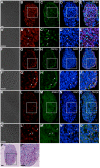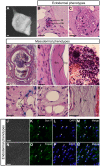Mouse embryonic dorsal root ganglia contain pluripotent stem cells that show features similar to embryonic stem cells and induced pluripotent stem cells
- PMID: 28373172
- PMCID: PMC5450311
- DOI: 10.1242/bio.021758
Mouse embryonic dorsal root ganglia contain pluripotent stem cells that show features similar to embryonic stem cells and induced pluripotent stem cells
Abstract
In the present study, we showed that the dorsal root ganglion (DRG) in the mouse embryo contains pluripotent stem cells (PSCs) that have developmental capacities equivalent to those of embryonic stem (ES) cells and induced pluripotent stem cells. Mouse embryonic DRG cells expressed pluripotency-related transcription factors [octamer-binding transcription factor 4, SRY (sex determining region Y)-box containing gene (Sox) 2, and Nanog] that play essential roles in maintaining the pluripotency of ES cells. Furthermore, the DRG cells differentiated into ectoderm-, mesoderm- and endoderm-derived cells. In addition, these cells produced primordial germ cell-like cells and embryoid body-like spheres. We also showed that the combination of leukemia inhibitor factor/bone morphogenetic protein 2/fibroblast growth factor 2 effectively promoted maintenance of the pluripotency of the PSCs present in DRGs, as well as that of neural crest-derived stem cells (NCSCs) in DRGs, which were previously shown to be present there. Furthermore, the expression of pluripotency-related transcription factors in the DRG cells was regulated by chromodomain helicase DNA-binding protein 7 and Sox10, which are indispensable for the formation of NCSCs, and vice versa. These findings support the possibility that PSCs in mouse embryonic DRGs are NCSCs.
Keywords: Dorsal root ganglia; Mouse; Neural crest-derived stem cells; Pluripotency-related transcription factors; Pluripotent stem cells; Signaling molecules.
© 2017. Published by The Company of Biologists Ltd.
Conflict of interest statement
Competing interestsThe authors declare no competing or financial interests.
Figures














Similar articles
-
Roles of chromatin remodelers in maintenance mechanisms of multipotency of mouse trunk neural crest cells in the formation of neural crest-derived stem cells.Mech Dev. 2014 Aug;133:126-45. doi: 10.1016/j.mod.2014.05.001. Epub 2014 May 15. Mech Dev. 2014. PMID: 24836203
-
Differentiation of primordial germ cells from induced pluripotent stem cells of primary ovarian insufficiency.Hum Reprod. 2015 Mar;30(3):737-48. doi: 10.1093/humrep/deu358. Epub 2015 Jan 12. Hum Reprod. 2015. PMID: 25586786
-
Identification, cloning and expression analysis of the pluripotency promoting Nanog genes in mouse and human.Dev Dyn. 2004 May;230(1):187-98. doi: 10.1002/dvdy.20034. Dev Dyn. 2004. PMID: 15108323
-
Sox2, a key factor in the regulation of pluripotency and neural differentiation.World J Stem Cells. 2014 Jul 26;6(3):305-11. doi: 10.4252/wjsc.v6.i3.305. World J Stem Cells. 2014. PMID: 25126380 Free PMC article. Review.
-
The SOX transcription factors as key players in pluripotent stem cells.Stem Cells Dev. 2014 Nov 15;23(22):2687-99. doi: 10.1089/scd.2014.0297. Epub 2014 Sep 26. Stem Cells Dev. 2014. PMID: 25127330 Review.
Cited by
-
Phenotypical changes of satellite glial cells in a murine model of GM1 -gangliosidosis.J Cell Mol Med. 2022 Jan;26(2):527-539. doi: 10.1111/jcmm.17113. Epub 2021 Dec 7. J Cell Mol Med. 2022. PMID: 34877779 Free PMC article.
-
Navigating the Landscape of CMT1B: Understanding Genetic Pathways, Disease Models, and Potential Therapeutic Approaches.Int J Mol Sci. 2024 Aug 26;25(17):9227. doi: 10.3390/ijms25179227. Int J Mol Sci. 2024. PMID: 39273178 Free PMC article. Review.
References
LinkOut - more resources
Full Text Sources
Other Literature Sources
Molecular Biology Databases
Research Materials
Miscellaneous

